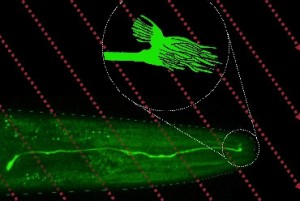Illinois State University’s Assistant Professor of Molecular Neuroethology Andrés Vidal-Gadea has been awarded a National Science Foundation (NSF) grant of $638,000 to study how animals detect the magnetic field of the earth.
“We understand how animals smell, touch, and hear, but we don’t really have much of an idea of how animals can detect magnetic fields,” said Vidal-Gadea, whose groundbreaking work in the field is placing his students on the cutting edge of science. “We know that animals use magnetic fields to migrate. From birds and monarch butterflies to ants, salmon, and sharks. They can use and orient to the magnetic field. Right now no one is sure how.”

Andres Vidal-Gadea’s team discovered the first sensor of the Earth’s magnetic field in animals in the brain of a worm.
The grant will support graduate and doctoral students in the lab, as well as activities for 15 undergraduate students, who will study the neurological systems of tiny worms known as C. elegans. Larger animal brains can possess millions of neurons, but the miniscule worm only contains around 300. “Three hundred neurons is really not that many. You probably have 300 friends on Facebook that you keep track of,” said Vidal-Gadea. “It’s the same for us. We can keep track of each neuron and understand a little bit about them. It also helps that they migrate in soil, unlike birds that can migrate around the globe.”
Vidal-Gadea’s team will continue to work on his discovery of magnetic beads or pearls near magnetic neurons. “Just like an oyster makes a pearl, some organisms can make magnetic pearls. In magnetic bacteria, these pearls align to form the shape of a needle, moving just like a needle in a compass.” The grant will help fund the study of genes in the worm in the hope of identifying the ones that are important for the creation and function of the pearls.
While labs around the world are working on the tie between magnetism and migration, Vidal-Gadea’s lab pioneers this work in the nematode C. elegans. “Figuring it out is one of the holy grails of sensory and neuroscience. And it’s fun,” he said.


